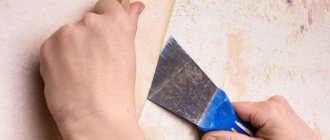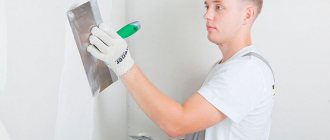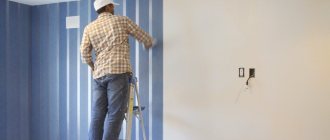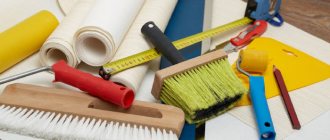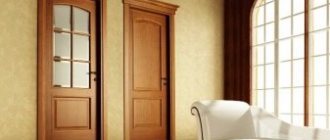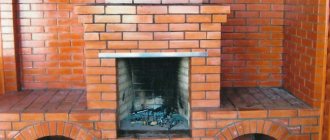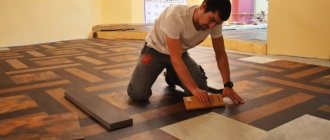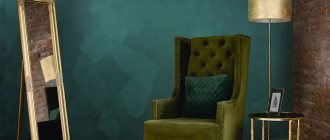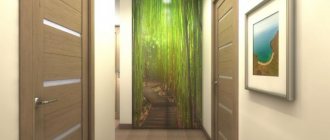The walls in the house should not only be beautifully finished, but also perform their function - reliable noise and heat insulation. So it’s not enough to choose beautiful wallpaper and think through the design of the room. First you need to prepare the walls themselves. This is done using a wallpaper backing. The use of such material will significantly improve living conditions in an apartment or house.
Functions
The substrate consists of several layers. In the middle, as a rule, there is foamed polyethylene, enclosed between layers of paper.
The wallpaper backing is a reliable insulator, which can be an important advantage in houses or apartments with cold walls.
Many multi-apartment “anthills”, both old and new, do not have good sound insulation. Residents hear other people's conversations, and not only in raised voices, but also music and harsh sounds from their neighbors. All this is unnerving and does not allow you to live in peace. Sound insulation is ensured by using a wallpaper backing. This material also allows you to overcome the problem of indoor humidity.
It is an excellent lining for any wallpaper. Using it, the outer decorative layer is easier to glue and it will look better on the walls.
Using a backing allows you to achieve maximum adherence of the finishing layer, even in problem areas such as corners and joints.
As a result, the finish will last longer and the problem of new repairs, as well as the material costs associated with it, will be postponed. Once upon a time, old newspapers were used as a backing. It was easier to glue wallpaper on them. Technology has come very far since then. Taking into account all the possibilities of modern substrates, their use cannot be considered a whim.
What should not be used for insulation?
Until recently, the first list included other methods of thermal insulation, but gradually they began to be abandoned, since although they allow you to retain heat, they still require more careful maintenance or regular replacement.
Among them:
- Isolon is a popular and well-known material that many have come across. But if it maintains the temperature in the room, then it is not advisable to glue wallpaper on it. Especially if you are a supporter of regular repairs. It will peel off along with the wallpaper strips and leave its parts on the walls, and then they will have to be cleaned and leveled for a long time. Not everyone wants to deal with this.
- Wood panels - in particular, laminated chipboard, some modifications of MDF. They are good as a finishing touch, especially if veneered. But it is still not recommended to glue anything on them.
Types and composition
The buyer can choose from several varieties of this roll material:
Paper
The backing base consists of paper. Its use is especially useful in cases where it is problematic to get rid of traces of the old finish. It sticks to the wall surface better than wallpaper. Its disadvantage is that it does not hide obvious flaws in the wall. In addition, this particular substrate is not particularly strong.
Non-woven
Externally similar to non-woven wallpaper, just as durable and easy to glue. At the same time, it is an expensive substrate. Not everyone will decide to buy it.
Cork
It is created on the basis of technical cork, and not decorative, so it is cheaper than finishing material made from cork. Its great advantage is its excellent sound absorption, which is indispensable if the house has thin walls and everything can be heard. But it needs to be installed skillfully and using special glue.
Polyethylene
This is a sandwich in which there is foamed polyethylene between two layers of paper. This material perfectly masks imperfections on the wall surface, and thanks to the inner layer it acts as a sound and heat insulator. It turns out to be an improved version of polystyrene foam, which is traditionally used to ensure silence in the room.
Why do you need to insulate walls under wallpaper?
The issue of thermal insulation of interior and inter-apartment floors arises in several cases:
Insulation is necessary when concrete slabs or brick structures freeze, there are microcracks and other damage that negatively affects living conditions. The insulation system prevents the formation of fungus, mold, and the appearance of black spots. Raises the average temperature in the room by several degrees. Acts as an additional leveling of the surface, which is especially important in apartments with uneven walls. Reduces humidity levels, which also prevents the spread of bacteria. Additionally, it suppresses noise, which has a beneficial effect on the overall emotional state of homeowners. Reduces heat loss and makes it possible to save on space heating in winter.
Benefits of use
In addition to the sound and heat insulation function, this material has many advantageous characteristics. The advantages of its use lie in the fact that it is environmentally friendly and therefore applicable in any home. The surface of most substrates does not absorb liquid. Accordingly, condensation does not form on it, and it will be able to protect the house from fungus for decades.
This coating partially levels the base on which it is located. Small cracks and chips on the surface can be successfully hidden using this material.
Its properties do not change for at least twenty years. Some manufacturers give it a half-century guarantee. Therefore, having once spent money and time on the purchase and installation of such a substrate, you can make your life easier with subsequent repairs, when you have to change the wallpaper again and again. The soundproofing feature of this material will be especially noticeable where walls separate the interior space from the street and common corridors. Good thermal insulation in these cases will also demonstrate itself successfully.
Purpose of the base
Wallpaper bases have been used for a long time. About 30 years ago, old newspapers were used for this, and then they were replaced by special paper.
Modern bases for wallpaper are high-tech materials that can not only facilitate the process of wallpapering walls, but also perform the functions of insulation and sound insulation.
Wallpaper backing is a wall covering with insulating properties.
Typically, wallpaper backings are made of polyethylene foam, lined with paper sheets on the back and front sides.
Instead of polyethylene foam, cork or non-woven fabric can be used to make the backing. The backings can be glued under any type of wallpaper.
This finishing material has the following advantages:
- high strength - it is difficult to tear;
- environmental safety;
- prevents condensation;
- serves as sound insulation.
The backing for the wallpaper is a soft roll finish, but despite this, it is highly durable.
There are reviews of the wallpaper backing that say it can withstand several re-pastings of wallpaper. New wallpaper is simply pasted onto the old backing without removing it from the wall.
The material prevents the appearance of mold on the walls and ensures silence in the room. In addition, using a wallpaper backing, you can even out unevenness on the walls.
Professionals increasingly advise sticking wallpaper not on bare walls, but on substrates, since the level of sound insulation in modern apartments leaves much to be desired.
Despite the fact that wallpaper backings are a universal material with many advantages, they also have disadvantages:
- not suitable for wet areas;
- not suitable for thin wallpaper - in this case the backing may show through;
- will not be able to isolate the room from extraneous sounds at high noise levels.
How to glue correctly?
Practice shows that wallpaper backing adheres remarkably well to concrete, wood, plywood, and drywall. In order to firmly glue it to the surface, you need to prepare the walls themselves for this: tear off the old wallpaper, remove any remaining paint, level out the depressions and seal the cracks with putty or cement mortar. Then you need to prime the surface. PVA glue or some other similar composition will do for this.
The backing strips themselves must be prepared for sticking to the walls in advance. They cut very easily. They must be divided into sheets taking into account the height of the walls and these sheets must be allowed to align.
So that they have time to straighten out, it is better to carry out the cutting a day before the start of pasting the walls.
Smooth sheets of material are coated on the inside with PVA glue or glue that is used for heavy wallpaper or under polystyrene. If there is a high level of humidity in the room, use baguette glue or liquid nails. (This, of course, will be more expensive, but you can be sure of the quality of the repair).
Taking all this into account, you need to act so that the glue does not get on the joints. Otherwise, the pieces of the backing will stick together and the seam between them will be uneven. The canvases with the applied glue are left for five to ten minutes, and then they are glued to the walls joint to joint - just like most modern wallpaper. In this case, the wall must also be coated with the same glue before this. Note that if the outer layer of the backing is non-woven and not paper, then only the wall itself needs to be coated with glue.
To ensure maximum adhesion to the wall surface, use a rubber roller, with which you squeeze out all the air from under the substrate and carefully roll it along the wall.
The gaps between the canvases must be sealed with paper tape or paper tape. To ensure that the result does not disappoint, just as in the case of wallpapering, drafts should be avoided. Experienced people advise carrying out the work itself at temperatures above +10 degrees and humidity less than 70 percent. If the room is cold, the glue will not set, but if, on the contrary, it is too hot, it will dry very quickly, and you may not have time to fix the entire substrate on the wall. Some areas will not be glued. Taking these features into account, it is recommended not to undertake such repairs in the spring or autumn, when there is high humidity and strong temperature changes.
After the job is done, you need to wait two days and only after that start decorating the walls with wallpaper.
Insulation with mineral wool under wallpaper
Required materials and cost
Basalt slabs are often used for finishing houses and residential premises. Known for its insulating properties:
- Retains heat perfectly.
- Does not freeze even in severe frosts.
- Completely safe for humans.
- Not subject to rotting.
- Not flammable and does not ignite from an open flame.
- Does not emit pungent, unpleasant odors.
- Does not wrinkle over time.
- Produced by many brands and sold at relatively affordable prices.
One drawback is the thickness of this material and the need to hide it under thin plasterboard slabs. In total, such finishing can eat up from 4 to 10 or more centimeters near each wall. Not everyone will agree to sacrifice free space.
Installation features
Another advantage of mineral wool is that old coatings can be left on interior floors, but only if the surface is fairly flat. If not, it is advisable to level it using special plaster.
- The work area is prepared, nails and dirt are removed, mold is treated with special compounds.
- Metal or wooden guides are placed at equal distances. It is advisable to give preference to steel or aluminum profiles. They take up less space and are easier to attach.
- Layers of mineral wool are laid between them - it is sold in cut layers, which greatly simplifies installation.
- Basalt sheets are fixed using special plates located on the guides. Moisture insulation, represented by a thin woven film, is placed.
- Drywall or chipboard is mounted on top, but the latter is much less common.
- The seams are treated with plaster, leveled and smoothed.
- After drying, any wallpaper can be glued to the surface.
You can learn more about the features of installing mineral wool in this video:
Offers from manufacturers
To choose the right backing for wallpaper, you need to keep in mind the experience of finishing professionals. The market offers wallpaper substrates of both foreign and domestic production. They can be found both in building materials stores and specialized wallpaper stores. Substrates from different brands may not be the same in thickness and material composition. So their cost sometimes varies greatly when compared.
Ecohit, Penohome, Globex, Penolon, Polifom are the most well-known manufacturers of wallpaper substrates. Among all the brands under which such materials are produced, experts highlight domestically produced Penolon and Polifom. "Penolon" has good thermal insulation properties. This is achieved due to air cells in its structure. The thickness of the material is only 5 millimeters. The roll width is 50 centimeters. A total of 14 meters per roll. At its core, Penolon is a chemically cross-linked polymer.
There are several varieties of such polymers - non-cross-linked gas foam, physically and chemically cross-linked. The cheapest among all is non-crosslinked polyethylene. In terms of strength and thermal insulation capabilities, it is 25% worse than physically and chemically cross-linked polymers. The last two, despite the fact that their manufacturing technology is different, are very similar in their characteristics. "Penolon" is hygienic. It is light and elastic. Resistant to alkali, acid, alcohol and gasoline. Easily straightens before sticking. Has low vapor permeability. Suitable for leveling surfaces, suppresses noise, eliminates cold coming from the walls, allows you to properly glue wallpaper, and eliminates the effect of “crying” walls.
“Polif” (sometimes also called “Poliform”) has the same geometric parameters as “Penolon”. It is also 14 meters long with a canvas width of 50 centimeters and a thickness of 5 millimeters. This is an environmentally friendly material that does not absorb moisture and prevents the spread of fungus and mold. This is a reliable heat insulator.
When choosing a material, experts advise paying attention to the color of the roll - it should be white or light gray. It also matters how firmly the paper layer is attached to the base. High-quality material is odorless and has a certain elasticity - after pressing with a finger, its surface should quickly return to its shape.
- When choosing a backing for wallpaper, it is better to focus on the reviews of craftsmen who have already gained experience in handling such materials, know all their pros and cons and how to use them correctly.
- You also need to keep in mind that before using such materials, if there is even the slightest hint of the presence of fungus, the wall surface must be treated with special chemicals. The underlay should not be used in baths and bathrooms.
- In rooms where the humidity is quite high, it is preferable not to use paper backings, since the paper itself does not tolerate dampness well. In these cases, it is better to use products made from non-woven fabric or cork.
- It is better to glue wallpaper made of dense material onto the backing, since thin ones can show through and the bottom layer will be noticeable. If you still choose thin wallpaper, you need the background color to be white. Otherwise, the color of the wallpaper itself will be distorted, and the resulting effect will unpleasantly surprise you.
- If gaps have formed between the canvases glued to the wall, you can disguise them with paper adjusted to the size of the gaps using glue. The substrate as such does not perform an absolute soundproofing function. This effect can only be achieved using special materials that require special fastening. Their thickness can reach 15 centimeters.
- A high-quality substrate does not smell of anything, does not emit dust or harmful substances. It is suitable for rooms where allergy sufferers and children live.
- The heat-shielding properties of such materials have been tested in practice. These qualities are especially noticeable on cold concrete walls. Experts willingly use substrates for finishing dachas and in block houses. This helps save on heating costs during the operation of housing and other facilities.
See the next video for more details.
Which wallpaper to choose for warmth in the apartment
But not only with the help of special insulation can you maintain a comfortable temperature in the apartment, but also with the help of the latest thermal wallpaper. This is a modern material that perfectly protects space from heat loss. Due to sophisticated production technology, they have a denser structure. They come in a variety of design options and can be a great addition to almost any interior.
They consist of two elements - a substrate and a top layer. The bottom one is made of thin polystyrene or cork, the second one is made of vinyl, non-woven fabric or paper.
Advantages and disadvantages of thermal wallpaper
Among their advantages it is worth noting:
- They are not afraid of humidity.
- Mold and mildew do not form on them.
- They are strong and difficult to scratch or damage.
- Installation is relatively simple and not complicated.
- They do not harbor insects.
- They do not emit unpleasant or pungent odors.
The main disadvantage of this material is its high cost. It will be expensive to decorate an entire room or apartment with them, but at the same time, such coverage is a profitable investment that does not require regular replacement. Only if you yourself do not like frequent changes.
Another disadvantage is flammability, but manufacturers are constantly updating the composition and new products are less susceptible to fire.
The third drawback is that they do not stick to a perfectly flat surface. But this is also different from many standard types of wallpaper.
How to glue thermal wallpaper?
They stick about the same as regular ones. The only difference is the type of substrate - for cork you need a special composition, for polystyrene standard solutions will also work.
- The surface is cleaned and, if necessary, covered with plaster.
- Treated with primer.
- Sections of wallpaper and walls are coated with glue.
- The piece is glued to the desired location.
- Three days are allowed for complete drying.
You can get acquainted with the installation features in this video, where plaster is used as an adhesive base, which is also suitable for attaching similar insulating materials:
It is important to remember that all types of wallpaper and insulation are installed in a closed, warm room. Ventilation, especially drafts, are unacceptable
It is also worth considering good ventilation for the room in advance, because if a lot of moisture accumulates in the space, then the entire effect of any insulation will be lost and the room will freeze.
Purpose
The substrate is foamed polyethylene, covered on both sides with paper. In addition to paper, cork or non-woven backing is sometimes used, which have received excellent reviews from customers. This is an excellent material that has a high level of sound insulation and is a thermal insulation coating. The backing is designed for pasting any type of wallpaper directly onto it.
It has a number of advantages:
- it is durable;
- environmentally friendly;
- not susceptible to microorganisms;
- does not absorb moisture and prevents condensation from appearing on the walls;
- soundproof (has a high level of sound insulation).
Thermal and sound insulation are the main advantages of this material
It should be said right away that before gluing the substrate you need to know how to glue it correctly. First you need to prepare the walls. They need to be freed from old wallpaper. Old paint is also removed, and cracks and pits are leveled using putty or cement mortar. The surface is primed; PVA glue or any other wallpaper glue is suitable for this purpose.
The day before pasting the walls, you need to cut the material into pieces according to the size of the walls, let it rest and level out. Smooth sheets should be coated with glue on the inside and allowed to stand for five to ten minutes. Glue is used for gluing polystyrene or heavy wallpaper. The process of gluing the backing is similar to wallpapering. The same technology, only the sheets must be glued end to end.
Removing air bubbles from under the surface is done with a rubber roller. The seams must be sealed with paper tape or narrow paper tape. The next step is to wallpaper the walls, but you need to let the backing dry for at least 1-2 days.
The practicality of the substrate lies in the fact that it does not change its properties for twenty years (some manufacturers guarantee fifty years). This allows you to use the substrate for several repairs, covering it with new wallpaper. This insulating material will protect rooms from the effects of fungus and condensation for several decades, will increase soundproofing and heat transfer, and this will be especially noticeable in those rooms whose walls face the street or common corridors. In addition to all that has been said, the substrate also acts as a leveling material for uneven walls.
Photo: foam
Insulation of walls under wallpaper with roll coverings
What will you need?
One of the most popular and widespread solutions. They are made from polystyrene. Both sides are treated with a protective coating suitable for further finishing. 0.5 cm thick, so they save space well. They provide excellent protection from the cold and resist the formation of fungus and mold. They do not require constant replacement and can easily survive several repairs.
When installed correctly, they do not peel off and help hide minor irregularities. Available only in white.
How to install correctly?
One unpleasant drawback that such roll insulation under wallpaper has is that it is advisable to glue them on flat surfaces. Therefore, installation is carried out in several stages:
- The walls are cleaned of old wallpaper and mold. Dowels, nails and other objects and fasteners are removed from them.
- A primer is applied, and specialized plaster of various colors is used for leveling.
- It takes from several hours to a couple of days to dry.
- Rolled insulation is most often attached to glue for heavy wallpaper (the surface and insulated wallpaper are coated with it), but can also be hung on tile adhesive.
- Each strip is placed adjacent to the previous one. The contact points are sealed with tape or other adhesive tape.
- Allow 72 hours to dry.
Installation features can also be found in this video:
How to glue correctly
When gluing with a thick backing, use glue designed for heavy wallpaper. The underlay is used to insulate walls. It insulates concrete walls especially well, which do not have good thermal insulation, and adheres well to almost all building materials (plasterboard, wood, plywood, concrete), as many buyers say in their reviews.
Pasting can be done with your own hands: this work is no more difficult than wallpapering; final treatment of the walls with putty is not required, since the material itself smoothes the walls. You will forget what mold and dampness are.
Before gluing, cut the roll into sheets, the length of which will be equal to the height of the walls, and straighten them by placing some weight. When gluing the next sheet, do not apply glue to the joints, otherwise the glued sheet may stick to the next one, and the seam will turn out uneven. After gluing, carefully seal the seams between the sheets with paper tape or paper tape. This will allow you to better even out the unevenness of the wall, and the wallpaper will look better. Before gluing the wallpaper, make sure that the backing is thoroughly dry and free of voids caused by air bubbles appearing under the backing.
Polifom is a fairly popular brand
It is enough to paste over the backing once and you can change the wallpaper several times without changing it. Before pasting, several conditions must be met:
- Do not glue the substrate at a temperature lower than plus ten degrees and a relative humidity of seventy percent. Failure to comply with these factors will result in the quality of the pasting suffering and in some places it will not stick at all. Therefore, when pasting walls, at a time when the heating is not yet working (in autumn), or it is not yet warm enough outside (in spring), it is necessary to use heaters to maintain the temperature parameter. Or wait for suitable weather.
- Before pasting the wall, it is necessary to treat it with the glue that you will use to glue the backing.
- Immediately before gluing, coat the substrate with glue and wait ten minutes. After gluing the backing, avoid drafts for at least a day.
Features of cladding the internal surface of the house
The impossibility of external thermal insulation of walls is in itself a disadvantage of the structure. To it you can add the following disadvantages of the lining inside:
- reducing the usable area of the room (in the case of insulation of the floor and ceiling, also the volume);
- although the temperature becomes higher, heat does not accumulate in the walls - they remain cold;
- the previous fact contributes to the formation of condensation, causing dampness, mold, corrosion, and the appearance of microorganisms.
Fortunately, there are also advantages, and the main one is the normalization of the indoor microclimate.
Distinctive features of the internal thermal insulation of the walls of a private house, regardless of the material of the latter, are:
- The presence of two additional layers - hydro- and vapor barrier. The first reduces the likelihood of moisture getting on the insulation from the outside, the second - from the inside (from the side of the rooms).
- Rapid change in room temperature when opening vents, windows, doors.
- When using some insulation materials, “cold bridges” may appear - sections of the walls where condensation with cold air is concentrated.
- If possible, it is worth using environmentally friendly material for interior cladding.
- You can save money on wall insulation, which cannot be said about exterior work.
- Carrying out work inside the house in comfortable conditions all year round - the process will not be affected by natural factors.
- The presence of assistants is not necessary - all stages can be easily completed independently.
Important requirements are imposed on the structure at the preparatory stage of interior cladding. The key one is maximum dryness of the walls.
Main manufacturers
Before you start looking for where to buy underlayment, you should keep in mind that different types are made by different manufacturers. They differ in the thickness of the material, the quality and colors of the paper, and also in the selling price. We list the main brands offered for sale in Russia and the CIS countries:
- Ecoheat.
- Penolon.
- Polyf (some call it Poliform).
- Penohome.
- Globex.
Diagram showing the main advantages
To ensure that the subsequently pasted wallpaper does not change color or tone, you should choose a backing with white paper, since gray can appear on thin and light-colored wallpaper.
Like wallpaper, the backing is sold in rolls fourteen meters long and half a meter wide.
Is alignment necessary?
Wallpaper is still the most popular type of interior decoration. There are many types of materials on the construction market, from simple paper to silk-screen printing, non-woven and 3D. By gluing one of the types on the walls, be it plain paper or striped with silk thread, they should make the room cozy and the surface beautiful. To do this, the plane must be flat.
To level the plane, there are 4 materials, the use of which depends on the curvature and defects:
- wall curvature up to 2-3 mm - leveling with putty;
- if the walls are uneven 5 mm - use plaster;
- large curvatures of 10 cm - the use of plasterboard sheets;
- small errors - paper gluing.
Benefits of use
It is worth knowing some features of the use of the substrate and its advantages:
- Do not use the underlay in rooms with high humidity (bathroom, bathhouse).
- If there is already fungus on the walls, then you should not glue the substrate on it; first, ensure the complete destruction of fungal formations mechanically or with chemicals.
- Any gaps that appear between the sheets of backing can be sealed with paper strips adjusted to the size of the gap and PVA glue.
- Wallpaper underlay is not an ideal panacea for noise; there are more effective materials for sound insulation, but their installation requires special fastening, and they have a thickness of three to fifteen centimeters. This is where the substrate wins: it is an inexpensive material, easily sticks to the walls, and the work can be done by an unskilled person.
- Thanks to the materials used in the backing, it is easy to cut and the paper backing is easy to glue.
- The material is odorless, does not emit dust into the air, is environmentally friendly, can be used in children's rooms, and is absolutely harmless to human health.
- The ability to increase thermal insulation in places where the walls have low heat-insulating properties: dachas, block houses.
Ecohit is one of the common options
With the development of energy-saving technologies, the use of this material allows saving heat, although not in large quantities. In any case, savings are felt throughout the heating season.
The need to insulate the internal surface
If the design of a country house allows thermal insulation work to be carried out outside and inside, it is better to implement both methods. Alas, some circumstances force residents of private buildings to neglect external insulation. These include:
- location immediately behind the wall of another building or other object, the distance to which does not allow placing a layer of heat insulation;
- passage of energy cables and similar equipment along or inside walls that cannot be removed;
- the presence of an expansion joint between buildings behind the wall;
- authorities ban on modifying the façade (for example, a cultural heritage site);
- acute reluctance of residents to change the appearance of the building.
If at least one of the above conditions occurs, you can limit yourself to insulating the walls inside.
